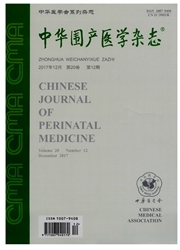

 中文摘要:
中文摘要:
目的 探讨双胎妊娠胎儿发育不均衡的临床特点及预后.方法 回顾性分析2000年1月1日至2012年7月31日在北京大学第一医院产科分娩的576例双胎妊娠孕妇(除外双胎输血综合征病例)资料.根据胎儿腹围以及股骨长估计胎儿体重,分娩后记录新生儿出生体重,根据公式[(较大儿体重-较小儿体重)/较大儿体重×100%]计算双胎体重的差异,体重差异≥25%考虑存在胎儿发育不均衡,<25%为胎儿发育均衡.分析双胎妊娠胎儿发育不均衡的发生率;比较胎儿发育不均衡者(不均衡组,68例)与胎儿发育均衡者(均衡组,508例)的母体并发症(子痫前期、胎膜早破、妊娠期糖尿病、产后出血等)发生率、早产率、围产儿病死率、新生儿出生体重和新生儿合并症(心血管系统疾病和颅内病变)发生率.统计学分析采用t检验或卡方检验. 结果 576例双胎妊娠中,胎儿发育不均衡总体发生率为11.8%(68/576).单绒毛膜双胎胎儿发育不均衡发生率[17.6%(40/227)]高于双绒毛膜双胎[8.0%(28/349)],差异有统计学意义(x2=11.40,P<0.05).胎儿发育不均衡组分娩孕周小于均衡组[(35.6±4.1)周与(36.6±3.2)周,t=1.66,P<0.05],早产率高于均衡组[58.8%(40/68)与47.6% (242/508),x2=3.85,P<0.05].不均衡组围产儿病死率高于均衡组[9.6%(1 3/136)与4.7% (48/1 016),x2=5.84,P<0.05].胎儿发育不均衡者中,单绒毛膜双胎妊娠新生儿颅内病变的发生率明显高于双绒毛膜双胎组[20.9%(14/67)与6.8%(3/44),x2=4.06,P<0.05].结论 双胎妊娠胎儿发育不均衡孕妇较易发生不良妊娠结局.应加强产前保健,并及时评估胎儿的宫内状况,分娩后建议对新生儿进行全面检查并长期随访.
 英文摘要:
英文摘要:
Objective To investigate clinical characteristics and outcomes of twin pregnancies complicated with growth discordance. Methods Five hundred and seventy-six twin pregnancies who delivered between January 1, 2000 and July 31, 2012 in Peking University First Hospital were retrospectively analyzed. Cases with twin-twin transfusion syndrome had been excluded. Fetal weight was estimated by abdominal circumference and femur length; neonatal birth weight was recorded. The weight difference between two babies was divided by the weight of the bigger one to obtain the differential ratio. Twin pregnancy complicated with growth discordance was diagnosed if the ratio was equal or greater than 25% ( discordance group, n=68 ) , and growth concordance was diagnosed if the ratio was less than 25% ( concordance group, n=508 ) . The incidence of twin pregnancies complicated with growth discordance was analyzed. The incidence of maternal complications, premature delivery, perinatal death and neonatal complications were compared between the two groups. Chisquare test and t test were used for statistical analysis. Results The incidence of twin pregnancies complicated with growth discordance was 11.8% ( 68/576 ) . The incidence of growth discordance in monoehorionic twins was higher than that in dichorionic twins [17.6% ( 40/227 ) vs 8.0% ( 28/349 ) , Z2=11.40, P〈0.05]. The gestational age at delivery in the discordance group was earlier than that in the concordance group [ ( 35.6 ±4.1 ) weeks vs ( 36.6±3.2 ) weeks, t=1.66,P〈0.05], and the incidence of premature delivery in the discordance group was higher than that in the concordance group [58.8% ( 40/68 ) vs 47.6% ( 242/508 ) , Z2=3.85, P〈0.05]. The perinatal mortality in discordance group was higher than that in the concordance group [9.6% ( 13/136 ) vs 4.7% ( 48/1 016 ) , Z2=5.84, P〈0.05]. Among babies in discordance group, the incidence of intracranial lesion in monochorionic twins was higher than that in dichorionic twins [20.
 同期刊论文项目
同期刊论文项目
 同项目期刊论文
同项目期刊论文
 期刊信息
期刊信息
